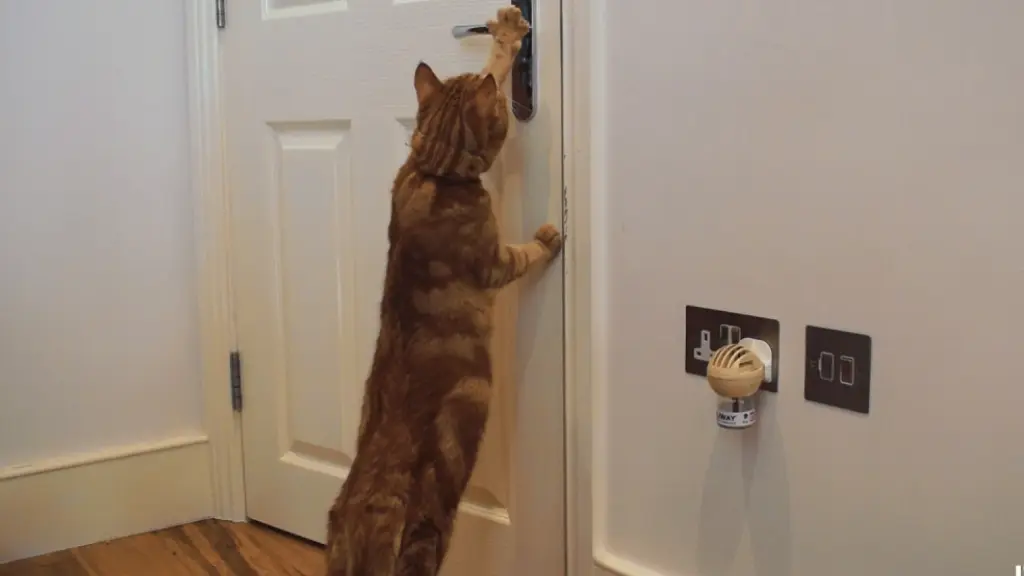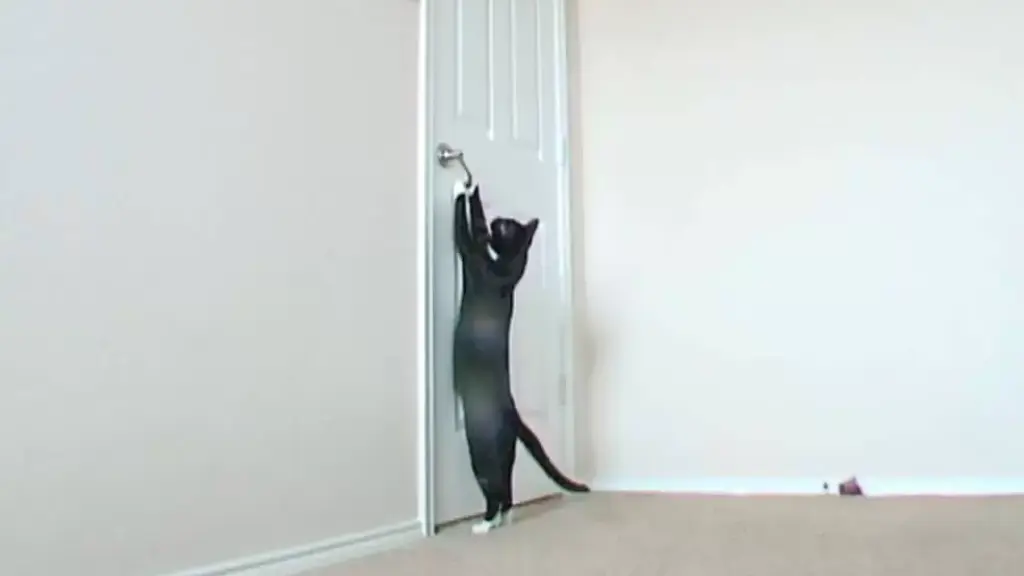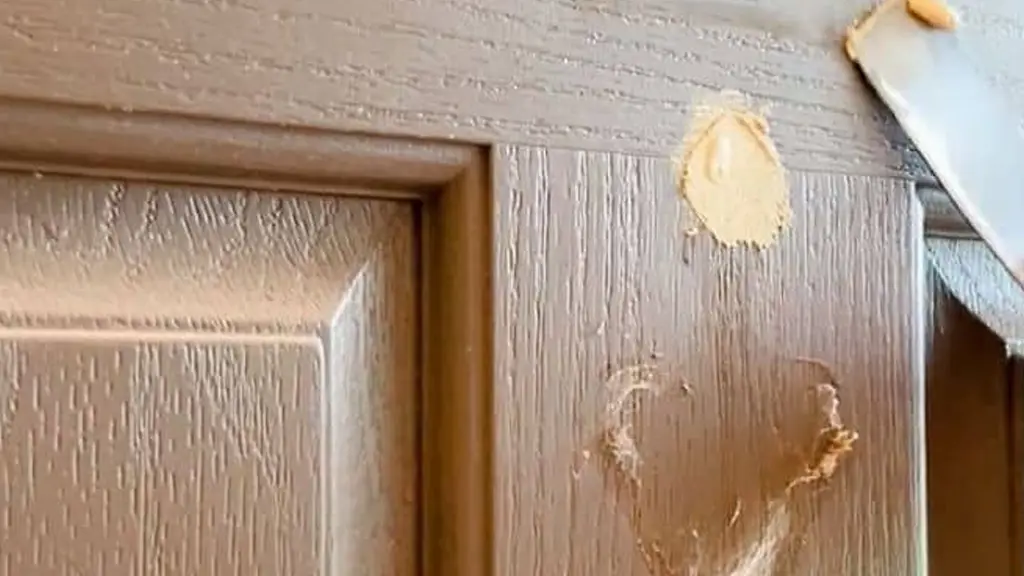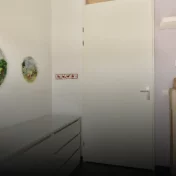Cat scratches on door frames are an unfortunate but common issue for cat owners. Over time, these claw marks can become unsightly and cause damage to the wood.
Luckily, with the right know-how and materials, fixing scratched door frames is a straightforward DIY project. This guide will walk you through the simple steps to achieve professional-looking results, restoring your home’s door frames and maintaining a damage-free environment for your cat’s scratching needs.

First, carefully inspect the scratches to assess the severity of the damage. Minor scratches may only require cleaning and a fresh coat of paint while deeper gouges may necessitate the use of wood putty. From there, matching the existing paint color is key to an invisible repair.
Apply wood putty if needed, then sand and vacuum the area before applying at least two coats of fresh paint for full coverage.
With a bit of time and the right materials, you can easily restore scratched door frames, providing your feline friend with an appropriate scratching surface while maintaining your home’s pristine aesthetics.
Let’s get started on learning how to confidently tackle this common cat owner challenge and fix those door frame scratches for good.
How to Fix Cat Scratches on Door Frame
Let’s get started on learning how to confidently tackle this common cat owner challenge and fix those door frame scratches for good.
Assess the damage and clean the scratches

Inspecting the scratches closely is the first step towards determining the proper repair method. To assess the damage:
Get a good light source and inspect the scratches at an angle against the light. This will reveal the true depth and severity of the marks. Pay special attention to any areas where the wood grain has been gouged out.
Minor surface scratches that do not penetrate the topcoats of paint may only require a thorough cleaning and fresh coat of paint for coverage. For these lighter scratches, skip any wood putty and move straight to cleaning and painting.
Deeper scratches that go below the paint layers and penetrate the wood may necessitate the use of wood putty for a smooth repair. Keep note of any deeper scratches that will require filling.
Once you have a clear picture of the extent of the damage, move on to gently cleaning the scratched area to remove any debris or wax buildup.
Mix a small amount of warm water with a small amount of dish soap in a bucket. Use a clean rag or sponge dampened with the solution to wipe down the scratched area. Thoroughly rinse the area with clean water and allow it to dry completely before proceeding with the repair.
By taking the time to accurately assess the scratch depth and performing a gentle clean, you have prepared the surface for the most effective repair, whether that involves only paint or paint with addition of wood putty for deeper scratches.
Match the paint color

The key to an invisible repair of cat scratches on door frames is matching the existing paint color as closely as possible. Here are the steps to achieve a perfect paint match:
Visit your local home improvement or paint store and gather several paint color samples that appear close to the existing paint on your door frame. Color names alone may be misleading, so bringing an actual paint sample from the door frame is ideal.
Compare the color samples side by side against the door frame’s existing paint in natural light. Examine how the samples look against the existing paint from multiple angles to determine the ideal match.
If none of the paint store samples are a perfect match, speak confidently with a store associate to request a custom mixed paint to most closely match the hue, chroma and value of your door frame’s paint. Provide the associate with your paint sample for the best color match results.
Once you have acquired the perfect shade of paint for your door frame, give it a thorough final stir before use to ensure even pigment distribution for a consistent color. Shake any aerosol spray cans vigorously for the same reason.
With a perfectly matched paint in hand, you are ready to move confidently forward with repairing those cat scratches. The color match will allow you to blend the paint seamlessly into the existing paint, leaving no visible sign of the repair once completed.
Armed with this knowledge, you can achieve an ideal paint match to repair cat scratches on any door frames or trim with confidence and success.
Apply wood putty (optional for deep scratches)

For deeper cat scratches that penetrate the wood grain, filling the gouges with color-matched wood putty will create a smooth surface for the paint to adhere to. Follow these steps to confidently apply wood putty:
Locate wood putty in a shade that closely matches the color of your door frame’s wood. Light-colored wood generally requires a light-colored putty while dark wood utilizes a darker putty. If needed, speak with store associates to find the ideal match for your project.
Remove a small marble-sized amount of putty from the container and begin kneading it vigorously in your hands for 30 seconds to 1 minute. This activates the hardening agents within the putty and improves its adhesion qualities.
Firmly press the kneaded putty into the deepest scratches, slightly overfilling the gouges. Use a damp finger, sponge or tool to wipe away any excess putty flush with the surface of the door frame.
Allow the putty to cure and dry fully according to the product instructions, typically several hours up to 24 hours. A light sanding before painting will ensure full adhesion of the paint to the putty.
With confidence in selecting the proper wood putty and correctly applying it to fill deep cat scratches, you have set yourself up for success in achieving a seamless repair that requires no visible signs of damage once painted.
Speak with certainty to family and friends about your newfound knowledge and skills in fixing cat-scratched door frames like the pro you are.
Sand the area
Now that any wood putty has fully cured, the next step is to use sandpaper to smooth the surface in preparation for paint.
With the right technique and materials, you can confidently achieve a seamless surface for your paint to adhere to. Here’s how:
Choose a fine-grit (120 to 220) sandpaper to gently remove any imperfections and create a texture for the paint to grip. Coarser grits could leave visible scratch marks that show through the final coat of paint.
Fold the sandpaper in half and wrap it around a sanding block for easier control and more even sanding pressure. Without a sanding block, it is easy to create uneven spots or gouges while sanding freehand.
Pressing firmly but gently, sand in straight lines along the wood grain of the door frame. Sand in both directions to ensure any unevenness is removed in multiple orientations.
Check your progress frequently by inspecting the sanded surface at an angle against a light source. You are looking for an even, uniform texture free from deep scratches or grooves that could telegraph through the paint.
When finished, vacuum up any leftover sanding dust thoroughly to ensure it will not interfere with paint adhesion. Even a trace of dust can cause bubbles or imperfections in the finished paint job.
Armed with the right supplies and knowledge, you can sand the repaired area of your door frame with confidence, creating a flawless surface for the paint to grip.
Soon those bothersome cat scratches will be completely invisible beneath your expertly applied fresh coat of paint.
Apply paint
Now you are ready to confidently apply the perfectly matched paint to cover up those unsightly cat scratches for good. Follow these steps to achieve professional-level paint results:
Select a small, high-quality synthetic bristle paintbrush appropriate for the size of the scratched area. Narrow brushes will allow for more control and precision.
Stir the can (or container) of paint thoroughly to ensure even pigment distribution and consistency. For spray paints, shake the can vigorously for at least one full minute.
Apply the first, thin coat of paint in the direction of the wood grain using smooth, even strokes. Avoid applying excessive amounts of paint which could drip or pool.
Allow the first coat to dry fully according to the can instructions, typically 1 to 2 hours. Inspect for any uncovered spots that may require additional paint.
Apply a second, slightly heavier coat of paint, again working in the direction of the wood grain for a seamless finish. Smooth any brush strokes with light, feathery passes.
Allow the second coat of paint to fully cure, typically at least 4 to 8 hours. Inspect the repair under different lighting conditions to ensure an invisible color match has been achieved.
Armed with the right supplies, a perfectly matched paint color and knowledge of proper application, you can confidently tackle fixing cat-scratched door frames with professional-level results.
Soon any signs of damage will be completely covered and invisible beneath your expert paint job.
With practice, repairing future scratches will become second nature – now you can truly think of yourself as a DIY painting pro!
Conclusion
With the proper know-how, a little time and the right supplies, fixing cat scratches on door frames is a straightforward and achievable DIY project for any pet owner.
By following the steps outlined in this guide – from inspecting the damage and choosing the right wood putty, to sanding the surface and applying perfectly matched paint – you now have the confidence and skills to tackle this common challenge and restore your home’s door frames to like-new condition.
Whether your furry feline friend has only light surface scratches to repair or deeper gouges that penetrate the wood, armed with the techniques shared here, you can achieve professional-level results and invisible repairs that show no signs of damage.
With practice, fixing future cat scratches will become second nature – and with some ground rules for your cat’s approved scratching areas, you may be able to avoid future repairs altogether!
Ultimately, by gaining the knowledge to confidently repair scratched door frames yourself, you save both time and money versus calling in a professional.
With some patience and the right supplies, even the deepest cat scratches can be transformed into a smooth, seamless surface beneath your expert paint job.
Soon your door frames will look as good as new, and you’ll be ready to tackle any future wear and tear that comes your way, furniture scratches and all!



